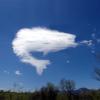Many people approach lure choice by having some confidence baits, and then looking for situations to match them. I'm the other way around, I look at the fish and conditions, then choose lures to apply. I re-think, re-adjust, adapt, as I go.
We all know lots of things catch bass. But some work better than others depending on the circumstances. In my mind, those circumstances are fish behavior and activity, and sky and water conditions.
I first try to decide where the fish are generally by season and in terms of actual lake lay-out (called location). Then I decide where in that location or structure they are -how close to cover, how high in the water column, etc...(this is called position). Then I try to determine what they are doing, their activity level -How easy they will be to dupe, how willing to chase they are, etc.. Essentially, I'm usually looking for the easiest fish to catch). Together these dictate the very basic controls: depth, speed.
From there other more specific things enter in to the mix:
-Cover present (weed type, algae, wood, rock, ...)
-Visibility conditions: Water clarity, cloud cover, time of day, cover.
-Other anglers present?
-How spooky are they? (Often directly related to visibility and other anglers).
-Prey type the bass are likely feeding on, or used to seeing.
-Triggering. What manipulations you apply to turn non-biters into biters.
-other stuff...
-How comfortable (which boils down to how experienced) you are with the lures in your possession. If you have lures you don't know much about, read about where they shine and then go have a practice session with them, figuring out what they do. Better, pay attention to fishing conditions you encounter, then go read up on (or ask) what lures shine in those types of conditions. Then get one or two and do your practice sessions.
If I'm using something I'm sure should work, then it may mean I haven't really found the fish yet, or I need to adjust the triggering -which may mean a different retrieve, or a lure change. If I'm still not catching, then I blame the fish, the lake, and the sky (LOL), meaning, I re-think parts of the above prescription; I've missed something. Maybe the majority of fish aren't still shallow, maybe they've dropped deeper now, or maybe my fish are right under that wind-blown algae on shore? Maybe they are feeding on bottom-gleaning bluegills and I need to try deeper. Maybe more speed, more aggressive triggering, more subtle... . Maybe they are holding just deep enough that with the new water color coupled with those thin clouds, the bass aren't seeing my topwater I need to go noisier, or slower, or subsurface. Maybe... You get the idea.
I suppose the bottom line is: If you aren't hitting them, there is a reason, and it's all about asking the right questions. I'd work on understanding what questions to ask.
Hopefully, when I finally find a bite, I let the fish tell me what details I need to adjust, to maximize the bite. I also watch conditions like a hawk so I can turn that corner with them. This is where I want to be and hopefully can get there before the sun goes down on me.
Not uncommonly, I've deduced several things that will work, and I'll switch rods on nearly consecutive casts: (i.e. Buzzer, slower topwater, swimming jig, free-falling tube). This'll often pull more fish out of a given spot than if I'd fished just one before moving on.
Lures are truly are tools, or maybe better, keys. They are not magic; the magic is in your knowledge of them and then ability to apply them in the right places at the right times which means knowing fish, water, and your own pieces of it. This isn't a precise science either. You may be able to apply a lure in a different way than another angler and make a key that fits a certain set of circumstances. In fact, if you get good at this you may find that making your own lure concoctions is the most satisfying. It's a nice place to be. It means you've grabbed the bait monkey by the b@!!$.





